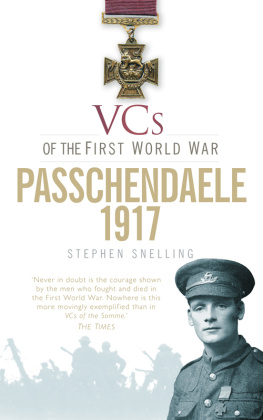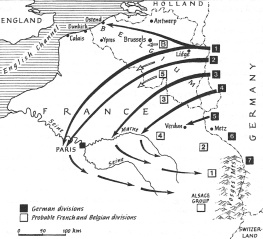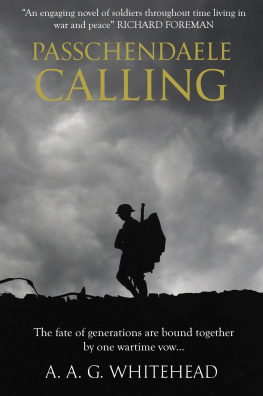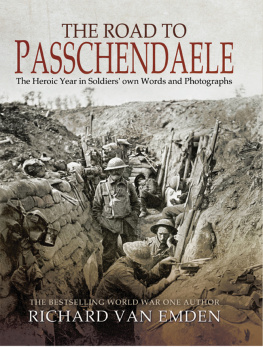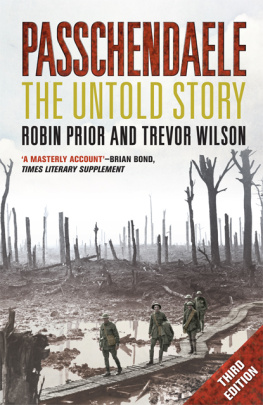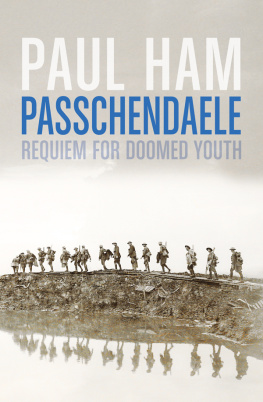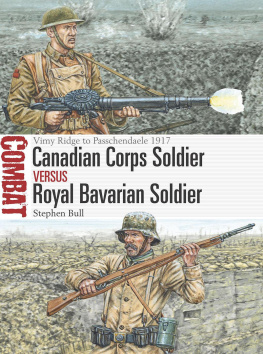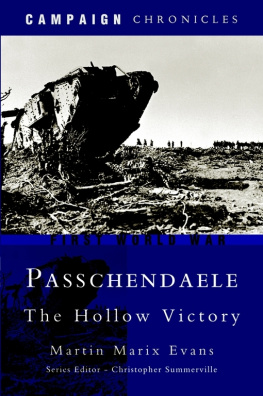
Looking back through my files of correspondence as I prepared the final draft of this volume brought home to me what a long road I had travelled. I started my research in the summer of 1991, long before this series was even envisaged, and since then my Passchendaele odyssey has taken me as far afield as Australia, Canada, New Zealand and South Africa, not to mention Eire and all the home nations.
One of the great joys of writing a book such as this is making contact with so many people in so many places; over the last six years I have been grateful for the assistance, moral and practical, from a small army of supporters. The pleasure of research, with all its thrill of the hunt, is, however, tempered by the sense of responsibility felt towards all those who have given so freely of their time. To have incorporated everything sent to me would have required another volume at least, but I hope that I have been able to do justice both to their efforts and to the memory of the sixty-one gallant men featured in this book.
With the help of numerous appeals published in newspapers around the world, I have been able to make contact with a large number of relatives of the men who won their Victoria Crosses during the Passchendaele campaign. It has proved one of the most fruitful avenues of research and I would like to place on record my thanks to the following for supplying me with a wealth of biographical material and previously unpublished family photographs: Don Andrew, Major-General the Viscount Monckton of Brenchley cb, obe, mc, dl , William Harrison, Marjorie Giles, Joe and Kathy Edwards, Grace McIntosh, S. Davies, Mary Moody, G. Armstrong, Edward Malet de Carteret, Dr Christopher Ackroyd, Arnold Loosemore, Joyce Lockier, Harry Cooper, William Ireland, Alisdair Skinner, Nicholas de Silva, Philippa Feeney, Jessie Rogers, Mollie Goggins, Barbara Newman, Gordon McGee, Shirley Kuo, Ivy Wrankmore, Christopher Evans, Reginald Hutt, James Ockendon, Fanny Brown, Ann Risley, Frank Bromley and Marjory Thompson.
Of the many fellow enthusiasts and researchers who have contributed greatly to my research, I would particularly like to thank Anthony Staunton, Ron Praite and Esme Smith, for assistance in Australia, Phillip OShea for his expert guidance and support in New Zealand, and W. James MacDonald, Terry Macdonald and Albert Hobson Thorn in Canada. I am also indebted to Donald C. Jennings of Gainesville, Florida, for generously allowing me access to what must be an unrivalled collection of photographs of VC graves and memorials. Nearer to home, my thanks go to Frank Gordon for checking my manuscript as well as offering suggestions on how it might be sensitively edited, to my colleagues Simon Finlay and Annette Hudson for their advice and practical assistance and to the ever-generous Dick Rayner for his support. As always the staff at Sutton Publishing have been a pleasure to work with and in Jonathan Falconer I found a most patient, considerate and enthusiastic ally in all my endeavours. Gerald Gliddon, fellow author and the man responsible for turning the idea of this series into reality, added support and much useful counselling whenever I seemed to become bogged down in the quagmire of research.
None of this, however, would have been possible but for the help given by the staff at countless regimental museums, local libraries and county record offices. To all of them, I shall be eternally grateful. In particular, I must thank Dennis Pillinger, the Military Historical Societys Custodian of the Lummis VC files at the National Army Museum, Nigel Steel at the Imperial War Museums Department of Documents, the staffs at the Public Record Office, Kew, and the National Library of Wales in Aberystwyth, and Chris Lloyd, assistant curator of social history at Queensland Museum, for sending me complete copies of Patrick Bugdens wartime correspondence and family papers not once but twice after the first set had been lost in the post.
Lastly, there is a group of people who must be singled out as deserving my undying gratitude my wife Sandra and daughters Katie and Holly. Together, they have made the greatest sacrifices, given the greatest support and shown the greatest tolerance. To them, therefore, must go the greatest thanks of all.
C ONTENTS
As most writers of military history will readily acknowledge, research rarely ever ends. In my experience, publication usually serves as a stimulus for discovering new sources of information and opening up new lines of enquiry. Of course, it can be also be a frustration, even an irritation, to suddenly find a vital clue to unlocking some hidden detail or to unearthing a previously unseen record within months of your book hitting the shelves. But thats the way it usually is, and certainly was so far as Passchendaele 1917 was concerned.
Its hardly surprising. Since it first appeared in 1998, there has been a technological revolution so far as historical research is concerned. At the heart of it is, of course, the internet. Its reach has become enormous and the opportunities for tracking down lost families or undiscovered sources have multiplied a thousand-fold, and more.
Coupled with the rapid advances in technology has been the release of important documents by official archives. The opening up of many of those service records to have survived the damaging results of a Second World War has been a boon to researchers. Though frequently disappointing, every so often they yield unimagined treasure troves. Meanwhile, in Australia and Canada, a benevolent approach to the custodianship of public records has made accessible much new material and rendered long-distance research a joy rather than a chore.
But, as ever, the most memorable sources of fresh information about the Victoria Cross recipients of the 1917 Ypres campaign have been the relatives who have generously opened their private archives to furnish me with anecdotes and letters, diaries and photographs, which add fresh layers of knowledge and interest to the biographical portraits of their brave ancestors.
In particular, I must thank Ian Robertson for allowing me access to papers and photographs relating to his great uncle, Clement Robertson, the Tank Corps first VC; Pam Colvin, daughter of William Hewitt, for her photographs and personal recollections; Anne Walsh for biographical information and photographs relating to her grandfather, Alfred Knight; Hazel Greaves for a wealth of material and memories about her father, Fred Greaves; and, lastly, Charles and John Moore, son and grandson respectively of Monty Moore, for their generous assistance and candour in discussing one of the campaigns more colourful heroes. They alone have made the hours of work spent writing this revised and expanded edition worthwhile.
I am grateful, yet again, to the ever-supportive team at The History Press, Jo de Vries, senior commissioning editor, and Paul Baillie-Lane, military history editor; to Gerald Gliddon, my chief collaborator in the VCs of the First World War series; to Dick Rayner, my knowledgeable and most generous-spirited of fellow researchers; and to Brian Best, founder of the Victoria Cross Society, whose regular journals continue to inform and inspire. Most of all, though, I have my wife, Sandra, to thank not just for her unswerving support and myriad sacrifices but for miraculously managing to never quite tire of a husband with a strange obsession that continues to defy rational comprehension.
The sufferings, privations and exertions which the soldiers had to bear were inexpressible. Terrible was the spiritual burden on the lonely man in the shell hole, and terrible the strain on the nerves during the bombardment which continued day and night. The Hell of Verdun was exceeded by Flanders. The Battle of Flanders has been called The greatest martyrdom of the First World War Looking back it seems that what was borne here was superhuman
Next page
